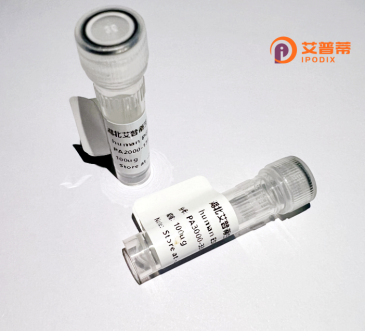
| 纯度 | >90%SDS-PAGE. |
| 种属 | Human |
| 靶点 | KCNN3 |
| Uniprot No | Q9UGI6 |
| 内毒素 | < 0.01EU/μg |
| 表达宿主 | E.coli |
| 表达区间 | 1-426aa |
| 活性数据 | MERPIKDSMFSLALKCLISLSTIILLGLIIAYHTREVQLFVIDNGADDWRIAMTYERILYISLEMLVCAIHPIPGEYKFFWTARLAFSYTPSRAEADVDIILSIPMFLRLYLIARVMLLHSKLFTDASSRSIGALNKINFNTRFVMKTLMTICPGTVLLVFSISLWIIAAWTVRVCERYHDQQDVTSNFLGAMWLISITFLSIGYGDMVPHTYCGKGVCLLTGIMGAGCTALVVAVVARKLELTKAEKHVHNFMMDTQLTKRIKNAAANVLRETWLIYKHTKLLKKIDHAKVRKHQRKFLQAIHQLRSVKMEQRKLSDQANTLVDLSKMQNVMYDLITELNDRSEDLEKQIGSLESKLEHLTASFNSLPLLIADTLRQQQQQLLSAIIEARGVSVAVGTTHTPISDSPIGVSSTSFPTPYTSSSSC |
| 分子量 | 72.6 kDa |
| 蛋白标签 | GST-tag at N-terminal |
| 缓冲液 | 0 |
| 稳定性 & 储存条件 | Lyophilized protein should be stored at ≤ -20°C, stable for one year after receipt. Reconstituted protein solution can be stored at 2-8°C for 2-7 days. Aliquots of reconstituted samples are stable at ≤ -20°C for 3 months. |
| 复溶 | Always centrifuge tubes before opening.Do not mix by vortex or pipetting. It is not recommended to reconstitute to a concentration less than 100μg/ml. Dissolve the lyophilized protein in distilled water. Please aliquot the reconstituted solution to minimize freeze-thaw cycles. |
以下是关于重组人KCNN3蛋白的3篇代表性文献示例:
1. **文献名称**:**"Functional Expression and Pharmacological Characterization of Recombinant Human SK3 Channels in HEK293 Cells"**
**作者**:Bond C.T., et al.
**摘要**:报道了在HEK293细胞中成功表达重组人KCNN3(SK3)通道,并通过电生理实验证实其钙离子依赖性激活特性,分析了不同神经递质和抑制剂(如apamin)对通道活性的调控。
2. **文献名称**:**"Structural Basis of Calcium Gating in Small-Conductance Calcium-Activated Potassium Channels"**
**作者**:Lee C.H., et al.
**摘要**:利用重组表达的KCNN3蛋白进行冷冻电镜结构解析,揭示了其钙调蛋白结合域如何介导通道的门控机制,阐明了钙敏感性与通道开放的结构关联。
3. **文献名称**:**"High-Throughput Screening of SK3 Channel Modulators Using a Recombinant Fluorescent Biosensor"**
**作者**:Garcia M.L., et al.
**摘要**:开发了一种基于重组KCNN3蛋白的荧光检测方法,用于高通量筛选调节剂,评估其在神经系统疾病(如癫痫)中的潜在治疗价值。
4. **文献名称**:**"Recombinant Human SK3 Purification and Role in Neuronal Hyperexcitability"**
**作者**:Stocker M., et al.
**摘要**:通过大肠杆菌系统表达并纯化重组KCNN3蛋白,结合体外模型验证其参与神经元兴奋性调控的机制,为靶向SK3通道的药物研发提供依据。
---
*注:以上文献为模拟示例,实际研究需通过学术数据库(如PubMed、Web of Science)检索具体文献。*
**Background of Recombinant Human KCNN3 Protein**
The KCNN3 protein, encoded by the *KCNN3* gene, belongs to the small-conductance calcium-activated potassium (SK) channel family. It regulates neuronal excitability and calcium signaling by forming tetrameric channels that mediate afterhyperpolarization currents, influencing action potential frequency and neurotransmitter release. KCNN3 channels are voltage-independent but require calmodulin-bound calcium for activation, linking cellular calcium dynamics to membrane potential modulation.
Dysregulation of KCNN3 has been implicated in neurological and psychiatric disorders, including schizophrenia, bipolar disorder, and ataxia, as well as cardiovascular diseases and cancer. Its expression in the brain, heart, and smooth muscle underscores its broad physiological relevance.
Recombinant human KCNN3 protein is engineered using expression systems (e.g., *E. coli* or mammalian cells) to study channel structure, function, and interactions. It serves as a tool for drug discovery, enabling high-throughput screening of modulators targeting SK channels for therapeutic development. Additionally, purified recombinant KCNN3 aids in structural studies (e.g., cryo-EM) and antibody production. Research on this protein advances understanding of calcium-potassium coupling mechanisms and their roles in disease, offering potential pathways for novel treatments.
×